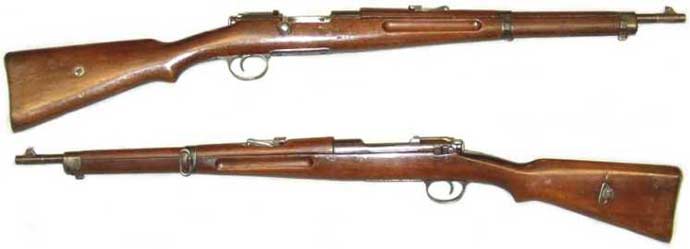
The Mannlicher-Schönauer (sometimes Anglicized as "Mannlicher Schoenauer") is a type of rotary magazine bolt action rifle produced by Steyr-Mannlicher for the Greek Army in 1903 and later was also used in small numbers by the Austro-Hungarian Armies.
History
In the late 1800s, classic Mannlicher designs for the Austro-Hungarian armies were based on a straight-pull bolt mechanism based on obsolete large caliber cartridges. Around the turn of the Century the Steyr factory worked on new designs, using more effective modern cartridges, for both the Austro-Hungarian Armies and export purposes. The M-S rifle had specifications that allowed the flexibility of either service or sport versions, depending on market response. Interestingly, the bolt has a rotating action, more reminiscent of the competing Mauser design. The characteristic that makes this design break apart from others of the era was the innovative rotating spool magazine, designed by the Mannlicher protegee, Otto Schönauer. The rifle action was designed by Ferdinand Mannlicher and the rotary magazine by Otto Schönauer of the Österreichische Waffenfabriksgesellschaft (Austrian Arms-Manufacturing Company; now Steyr Mannlicher). This rifle should not be confused with its more widely manufactured cousin, the Steyr-Mannlicher M1895, or the so-called Mannlicher-Carcano, made infamous in the assassination of President John F. Kennedy by Lee Harvey Oswald. However, the balistics and penetration of the 6.5x52 mm cartridge loaded with the 160 grain full military jacketed 6.5 mm bullet in the rifle used by Oswald, are essentially identical to that of the big game hunters using the same bullet with the 6.5x54 Mannlicher.
Service Use
Most of the foreign Mannlicher clients opted for versions of the standard Austro-hungarian rifle, M1895. The only success for the alternative export rifles was when the 6.5mm Mannlicher-Schönauer M1903 fulfilled the specifications of the Greek Army. That was part a major modernisation plan; until then the Greeks were using single-shot rifles ( Gras rifle). Most of the Greek Gras were made by the Steyr factory and that might partly explain how Mannlicher advertised their new design. This rifle was the main small arm for the Greek military for some of the most active years of its modern history. Greece was almost continuously in state of war between the years 1904-1922 and 1940-1948. The version history of this rifle is rather confusing. It appears that the Greeks received three main contracts. The original Steyr-made, starting at 1904-1905 was the main weapon during the victorious Balkan Wars. The Greeks seemed satisfied with the rifle's performance and losses were replenished with a new supply in 1914, with minor changes. These rifles were used for the first time in the WW1. Following the Asia Minor Catastrophe, the Greeks were in urgent need of serviceable weapons and tried to get M-S from every possible source. A last official contract was in 1930, when they received "Breda" marked rifles. This Italian factory might not even have manufactured their parts, but might have mediated on behalf of the Steyr factory, due to treaty restriction to Austrian weapon manufacture. These rifles had extensive use against the Italians and Germans in the WWII and many passed to the resistance fighters and combatants of the Greek Civil War that followed.
Despite its good performance, it was only the Greek government that chose the M-S as official service rifle. Only due to expediency other countries made limited use of them too. At the break of the WWI, a significant number of 6.5mm Mannlicher-Schönauer rifles manufactured for Greece under the 1914 contract, were sequestered, due to urgent needs, and used from the Austrian Army. After the dissolution of the Empire, large numbers were given for free to the intended recipient, the Greek Army, as war reparations. Small numbers also saw occasional use by Greece's enemies as was booty.
Improvement attempts
Two Greek-designed improvements for the weapon proposed during its operational use by the Greek Army never materialized: one was the so-called "Philippides design," which failed to go to production in 1925 due to a late submission of designs to Breda, which had undertaken construction in Italy; and another, designed by Lieutenant R. Rigopoulos just before World War II. This latter design incorporated both modified and totally redesigned parts to dramatically increase firing performance. Though approved by the Greek military, the weapon never went into producion due to interruption of test construction in Volos after Greece's entrance to the War.





